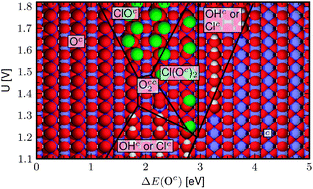Electrochemical chlorine evolution at rutile oxide (110) surfaces†
Abstract
Based on density functional theory (DFT) calculations we study the electrochemical

* Corresponding authors
a Department of Physics, Building 307, Center for Atomic-scale Materials Design, Technical University of Denmark, DK-2800 Kgs. Lyngby, Denmark
b Computational.Materials Design ApS, Fysikvej-Building 307-DTU, DK-2800 Kgs. Lyngby, Denmark
c Materials Sciences Division, Lawrence Berkeley National Laboratory, Berkeley, USA
Based on density functional theory (DFT) calculations we study the electrochemical

 Please wait while we load your content...
Something went wrong. Try again?
Please wait while we load your content...
Something went wrong. Try again?
H. A. Hansen, I. C. Man, F. Studt, F. Abild-Pedersen, T. Bligaard and J. Rossmeisl, Phys. Chem. Chem. Phys., 2010, 12, 283 DOI: 10.1039/B917459A
To request permission to reproduce material from this article, please go to the Copyright Clearance Center request page.
If you are an author contributing to an RSC publication, you do not need to request permission provided correct acknowledgement is given.
If you are the author of this article, you do not need to request permission to reproduce figures and diagrams provided correct acknowledgement is given. If you want to reproduce the whole article in a third-party publication (excluding your thesis/dissertation for which permission is not required) please go to the Copyright Clearance Center request page.
Read more about how to correctly acknowledge RSC content.
 Fetching data from CrossRef.
Fetching data from CrossRef.
This may take some time to load.
Loading related content
